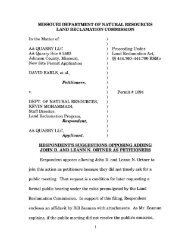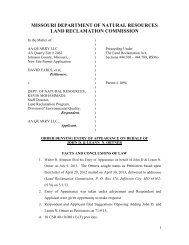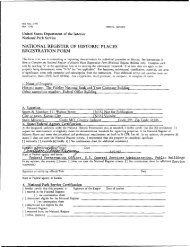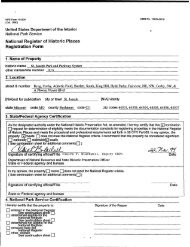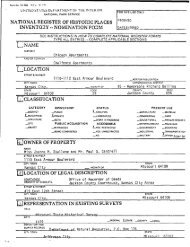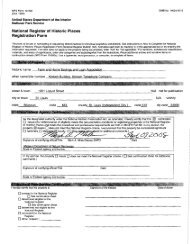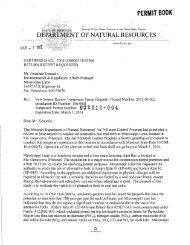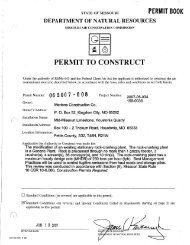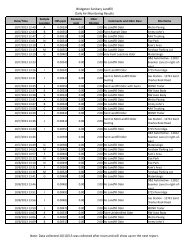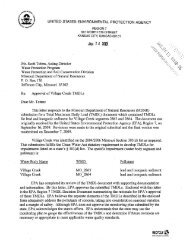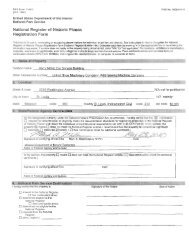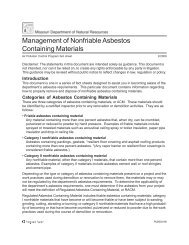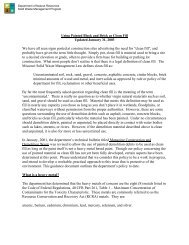Winter 2006 - Missouri Department of Natural Resources
Winter 2006 - Missouri Department of Natural Resources
Winter 2006 - Missouri Department of Natural Resources
Create successful ePaper yourself
Turn your PDF publications into a flip-book with our unique Google optimized e-Paper software.
DNR photo by Scott Myers<br />
role <strong>of</strong> preservation and protection <strong>of</strong> the<br />
state’s natural and cultural resources. At the<br />
same time, the public’s desire to learn about<br />
outdoor life in a park setting was growing.<br />
Park naturalists would come to play a vital<br />
role in fulfilling that desire.<br />
Afew state parks had been <strong>of</strong>fering nature<br />
guide services. However, these<br />
services were unstructured and not well<br />
known to the public. In 1938, state park <strong>of</strong>ficials<br />
hired Uncas McGuire as a chief naturalist<br />
on a seasonal basis. McGuire initiated<br />
special nature programs and activities to attract<br />
the general public.<br />
In a letter dated March 2, 1939, E. A.<br />
Mayes, a state planner in charge <strong>of</strong> park operations,<br />
wrote: “A wise use and an appreciation<br />
<strong>of</strong> our state parks is absolutely essential<br />
if our department is to serve the best<br />
interests <strong>of</strong> the park areas and our people.”<br />
He indicated that because the nature programs<br />
had been so well received by the general<br />
public, there would be six seasonal naturalists<br />
hired for the 1939 season.<br />
State and national park leaders recognized<br />
the need for pr<strong>of</strong>essional training to<br />
ensure a well-rounded naturalist staff.<br />
Mayes, McGuire and other state <strong>of</strong>ficials<br />
developed a two-day training session for the<br />
1939 season. Faculty from the University <strong>of</strong><br />
<strong>Missouri</strong>-Columbia departments <strong>of</strong> anthropology,<br />
geography, entomology, geology,<br />
history, forestry and zoology agreed to participate<br />
in the training. The result was the<br />
first <strong>of</strong>ficial training session for seasonal<br />
naturalists, held on the Columbia campus,<br />
June 1 and 2, 1939.<br />
The following year, state park <strong>of</strong>ficials<br />
selected George E. Moore, regarded by<br />
some as <strong>Missouri</strong>’s most outstanding scientist<br />
<strong>of</strong> natural history, as <strong>Missouri</strong>’s first<br />
full-time chief naturalist. As chief naturalist,<br />
Moore, with his wife Polly, who was an<br />
accomplished naturalist in her own right,<br />
traveled statewide, wrote articles for major<br />
newspapers and hosted a radio program.<br />
When the National Park Service<br />
broached the idea <strong>of</strong> an interstate park naturalist<br />
conference, <strong>Missouri</strong> took the lead<br />
and, with Moore’s help, sponsored the<br />
event. Leaders from around the country met<br />
at Meramec State Park on May 11-13, 1941.<br />
The 38 participants <strong>of</strong> this nationally significant<br />
training session came from nine states,<br />
as well as the U.S. <strong>Department</strong> <strong>of</strong> the Interior.<br />
<strong>Missouri</strong> was becoming known nationally<br />
for a high level <strong>of</strong> naturalist training.<br />
In 1977, George Kastler, who began his<br />
career as a park seasonal naturalist in 1964,<br />
was hired as the system’s fifth full-time<br />
chief park naturalist, a position he holds<br />
today. Under his leadership and guidance,<br />
the number <strong>of</strong> seasonal naturalists grew and<br />
the scope <strong>of</strong> training expanded to include<br />
both cultural and natural history.<br />
“When I became the chief park naturalist,”<br />
Kastler explains, “my goal was to continue<br />
the standards that George and Polly<br />
Moore set years earlier for state park interpretation.<br />
I knew that involved increasing<br />
our seasonal staff and providing them with<br />
the best training available.”<br />
(Below) During the Kaleidoscope<br />
event, trainees learn<br />
an American Indian firestarting<br />
technique using a<br />
fire bow.<br />
(Bottom) Trainees practice<br />
using a prehistoric device,<br />
the atlatl, that allowed<br />
spears to be thrown greater<br />
distances. The atlatl and the<br />
spear were made from natural<br />
materials such as river<br />
cane, antlers and chert.<br />
<strong>Winter</strong> <strong>2006</strong> 3<br />
DNR photos by Scott Myers



